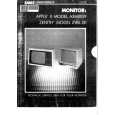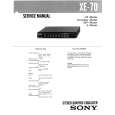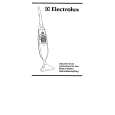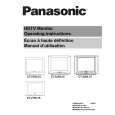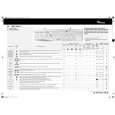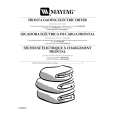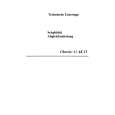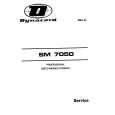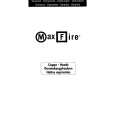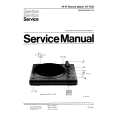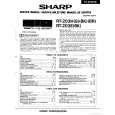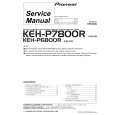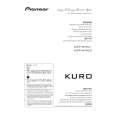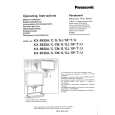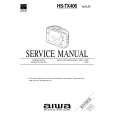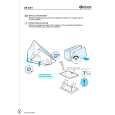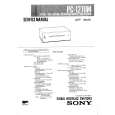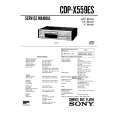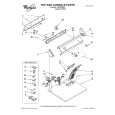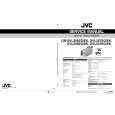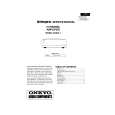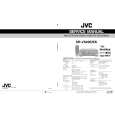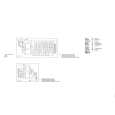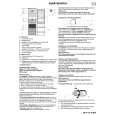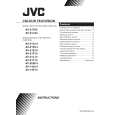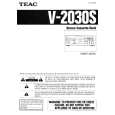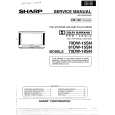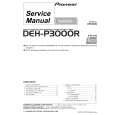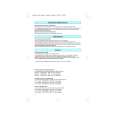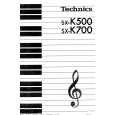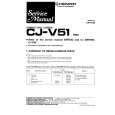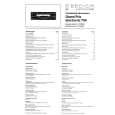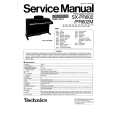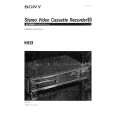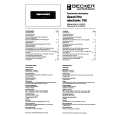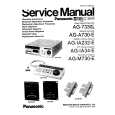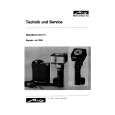|
|
|
Productos
|
|
Información
|
|
Destacado
|
|
|
 |
|
|
No hay comentarios de productos.
KMD-D401
TEST MODE / ADJUSTMENT
3. Description of key operations
The following operations are available in the mechanism test mode. (Note) With certain kinds (destination types) of H/U, Holding a control key depressed may not cause continuous operation. In this case, perform operation by tapping the control key repeatedly. (1) �Preset 5� key on the H/U While this key is held depressed, the LOAD/EJECT motor (MM3) rotates in the disc loading direction. (2) �Preset 6� key on the H/U While this key is held depressed, the LOAD/EJECT motor (MM3) rotates in the disc ejection direction. (3) �DISC UP� key on the H/U While this key is held depressed, the ELEVATOR motor (MM5) rotates in the elevator up direction. (4) �DISC DOWN� key on the H/U While this key is held depressed, the ELEVATOR motor (MM5) rotates in the elevator down direction. (5) �Preset 3� key on the H/U When this key is held depressed, the mechanism moves to the transport position. The buzzer generates 2 beeps after completion of the movement. However, if any of the switches inside the mechanism is ON or a disc is left in the mechanism, no operation occurs and the buzzer generates 3 beeps. (6) �Preset 4� key on the H/U Every time this key is pressed, the current LPS position is read as the standard position of the mechanism. When the LPS voltage is within the tolerance (2.55 V ± 0.3125 V), it is stored in the EEPROM. If it is outside the tolerance, it is not stored in the EEPROM. When the readout is performed successfully, the buzzer generates a beep and the mechanism moves to the transport position. The buzzer generates 2 beeps after completion of the movement. If the readout is not performed successfully, no operation occurs and the buzzer generates 3 beeps. However, if any of the switches inside the mechanism is ON or a disc is left in the mechanism, no operation occurs and the buzzer generates 3 beeps. (7) �PLAY/PAUSE� key on the H/U Every time this key is pressed, the standard position value stored in the EEPROM will be loaded. When the loaded value is normal, the buzzer generates a beep and the mechanism moves to the transport position. The buzzer generates 2 beeps after completion of the movement. If the loaded value is abnormal, no operation occurs and the buzzer generates 3 beeps. The above operation is available even when one of the switches inside the mechanism is ON or a disc is left in the mechanism.
KMD-D401
ADJUSTMENT
<With a pre-mastered disc> 13. When the high-reflection pit play mode starts, perform the operations in step 5, 6, 7 and 8 above. 14. When adjustment completes, the playback stops so all you have to do for completing the adjustment is eject the disc. � The EF balance coarse adjustment is performed during this test mode. However, as it is an automatic adjustment, no external control is required to perform it.
ADJUSTMENT
After replacing the pickup, perform the focusing bias adjustment and write the adjustment value in the EEPROM.
Adjustment parameters
Adjustment condition : After setting the LADJ1 pin to Hi, reset-start the set. Adjustment keys Data save keys : Track Up/Down keys : Manual Up/Down keys (Holding of the adjustment key with certain sets)
Preparation
Prepare the H/U (5L type) and connect the power cord and changer cord to it.
Adjustment procedure (When performing this during setting, be sure to turn the set OFF in advance.)
1. Pull up pin 50 (LADJ1 (Check land L1)) of IC9 on the X33 unit to BU 5 V (Check land BU5). 2. Lead wires from check lands ARF and SAG (Servo GND) on the X33 unit so that they can be monitored with an oscilloscope. 3. Turn ON the set and reset the H/U. � Perform a total of three adjustments, i.e. with the lowreflection pit and groove of the recordable disc and the high-reflection pit of the pre-mastered disc. 4. Load a disc to enter the adjustment mode. <With a recordable disc> 5. The low-reflection pit play mode starts when �TNo.1� is displayed. The time-code display shows �50�. 6. While monitoring ARF on an oscilloscope, vary the focusing bias with the Track Up/Track Down keys. 7. To calculate the optimum value, vary each of the Up and Down keys to find the value at which the ARF waveform is troubled or at which the 3T waveform level drops, and read the center value between them. For example, when the value on the Up side is 58 and that on the Down side is 46, the center value that is 52 is the optimum value. 8. When the optimum value is calculated, display that value and press the Manual Up or Down key to save the value. (With an ordinary set, press and hold the Track Up/Down key.) 9. After the low-reflection pit adjustment in step 8 completes, the pickup automatically jumps to the Groove area. 10. The groove play mode starts when �TNo.2� is displayed. 11. The subsequent operations are identical to those described in steps 6, 7 and 8 above. 12. When the groove area adjustment completes, the playback stops so all you have to do for completing the adjustment is eject the disc. � The low-reflection pit contains only the TOC area and the total playtime is around 40 seconds. As the retry operation starts when the pit area is exceeded, the adjustment is invalid in this period.
Caution
1. Be sure to save the value at the end of adjustment of each medium. If you eject the medium without setting the adjustment
Display of service test modes (Display on the set)
Pit adjustment mode started Pit adjustment permitted Pit adjustment executing (�� = Adjustment data) Pit adjustment saved (Groove adjustment mode started) Groove adjustment permitted Groove adjustment executing (�� = Adjustment data) Groove adjustment saved (Normal completion) [01- __: __] [01- __: 50] [01- __: ��] [02- __: __]
[02- __: ��] [02- __: __]
Display of errors (�� = Error status) [��- __ : __ ]
�� = 03 : Error during EF balance adjustment of lowreflection pit �� = 04 : Error during focusing bias adjustment of lowreflection pit �� = 05 : Error during EEPROM writing of low-reflection pit adjustment result �� = 19 : Error during EF balance adjustment of groove �� = 20 : Error during focusing bias adjustment of groove �� = 21 : Error during EEPROM writing of groove adjustment result �� = 35 : Error during EF balance adjustment of highreflection pit �� = 36 : Error during focusing bias adjustment of highreflection pit �� = 37 : Error during EEPROM writing of high-reflection pit adjustment result
value and start the adjustment of another medium, the adjustment result of the former medium will not be saved. 2. To prevent deterioration of focusing, do not set an extreme focusing bias value on either Up or Down side. The value may be reset by retrying adjustment, error or invalidation of keys may also occur. In this case, restart the adjustment by reset-starting the set. (This is also applicable to the case in which you saved data calculated based on extreme values.) 3. Note on E-99 Although E-99 originally indicates a mechanism error, E-99 is also displayed when the EEPROM data is destroyed. As the EEPROM data may be destroyed if a wire is attached or detached while the power of the set (BU) is ON, be sure to shut down the power (BU) before proceeding to such an operation. This is also applicable to the connection or disconnection of a card cable (flexible cable) used in connection of the mechanism. (Normal operation cannot be obtained by turning the TO terminal Hi like with the MDS-1000.) 4. Note on IC10 (EEPROM) Be sure to use the W05-0858-00 when replacing the EEPROM. IC10 stores various initial data of the MD DSP. The adjustment data is saved by rewriting some of the above data at the end of each adjustment. Therefore, if the EEPROM does not store initial data, error will occur at the moment adjustment data is saved. Note that the capacity of the EEPROM has been changed from 1k to 2k following the provision of MDLP compatibility for the MD mechanism. As this has also resulted in change in the internal cables, care is required on the fact that the cables used in the MDC1000 and MDC-1100 series are no longer usable.
9
10
|
|
 |
> |
|
